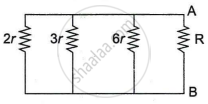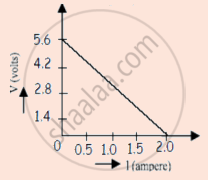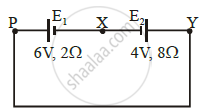Advertisements
Advertisements
प्रश्न
Three cells, each of emf E but internal resistances 2r, 3r and 6r are connected in parallel across a resistor R.
Obtain expressions for (i) current flowing in the circuit, and (ii) the terminal potential differences across the equivalent cell.
उत्तर

`R_{AB}` = ?
`1/(R_{AB}) = 1/(2r) + 1/(3r) + 1/(6r)`
`1/R_{AB} = 1/r[(3 + 2 + 1)/6]`
`1/R_{AB} = 1/r`
`R_{AB} = r` ⇒ equivalent internal resistant
Equivalent emf of cells in parallel,
`E_{eq} = (E_1/r_1 + E_2/r_2 + E_3/r_3)/(1/r_1 + 1/r_2 + 1/r_3)`
= `(E/(2r) + E/(3r) + E/(6r))/(1/(2r) + 1/(3r) + 1/(6r))`
`E_{eq} = E[(1/(2r) + 1/(3r) + 1/(6r))/(1/(2r) + 1/(3r) + 1/(6r))]`
Eeq = E
Current flowing in the circuit,
I = `E_{eq}/(R + R_{AB})`
I = `E/(R + r)`
Potential drop across E,
V = IReq
V = `(rE)/(R + r)`
APPEARS IN
संबंधित प्रश्न
Two identical cells of emf 1.5 V each joined in parallel, supply energy to an external circuit consisting of two resistances of 7 Ω each joined in parallel. A very high resistance voltmeter reads the terminal voltage of cells to be 1.4 V. Calculate the internal resistance of each cell.
In a potentiometer arrangement, a cell of emf 1.25 V gives a balance point at 35.0 cm length of the wire. If the cell is replaced by another cell and the balance point shifts to 63.0 cm, what is the emf of the second cell?
A secondary cell after long use has an emf of 1.9 V and a large internal resistance of 380 Ω. What maximum current can be drawn from the cell? Could the cell drive the starting motor of a car?
Two identical cells, each of emf E, having negligible internal resistance, are connected in parallel with each other across an external resistance R. What is the current through this resistance?
A battery of emf 100 V and a resistor of resistance 10 kΩ are joined in series. This system is used as a source to supply current to an external resistance R. If R is not greater than 100 Ω, the current through it is constant up to two significant digits.
Find its value. This is the basic principle of a constant-current source.
Apply the first law of thermodynamics to a resistor carrying a current i. Identify which of the quantities ∆Q, ∆U and ∆W are zero, positive and negative.
A straight line plot showing the terminal potential difference (V) of a cell as a function of current (I) drawn from it, is shown in the figure. The internal resistance of the cell would be then ______.

A cell of emf E and internal resistance r is connected across an external resistance R. Plot a graph showing the variation of P.D. across R, versus R.
A cell E1 of emf 6 V and internal resistance 2 Ω is connected with another cell E2 of emf 4 V and internal resistance 8 Ω (as shown in the figure). The potential difference across points X and Y is ______.

A block of metal is heated directly by dissipating power in the internal resistance of block. Because of temperature rise, the resistance increases exponentially with time and is given by R(t) = 0.5 e2t, where t is in second. The block is connected across a 110 V source and dissipates 7644 J heat energy over a certain period of time. This period of time is ______ × 10-1 sec (take ln 0.367 = -1).
